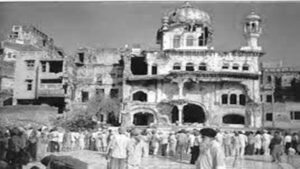Table of Contents
INTRODUCTION
Operation Blue star, a military operation was carried out from June 3 to June 8, 1984, to eliminate armed militants who were holed up in the Golden Temple. It was launched on the orders of the then prime minister Indira Gandhi to eliminate Jarnail Singh Bhindranwale and his followers who had sought cover in the Amritsar Harmandir Sahib Complex.
The Harmandir Sahib, also known as the Golden Temple, is considered the holiest site for Sikhs. The operation had to be carried out in order to get back control of the Golden Temple (Harmandir Sahib) from the militants.
What is Operation Blue Star?
Operation Blue Star was conducted for the first time just after the rise of the Khalistan movement in India, a political Sikh nationalist movement to create an independent state for Sikhs within the current North-Western Republic of India. The Khalistan movement began in the early 1940s and 50s, but it actually gained popularity between the 1970s- 80s. Bhindranwale was the leader of Damdami Taksal and was one of the major reasons behind this Operation Blue Star.
Bhindranwale, who was reportedly backed by ISI Pakistan, had made his demands clear – he wanted the Indian government to pass a resolution that would allow India to be divided, thereby creating a new country for Sikhs called ‘Khalistan’. Radical separatist Jarnail Singh Bhindranwale had started laying the groundwork for his demand in 1982, and by mid-1983 managed to gain support for his plan to divide India. In mid-1983, Bhindranwale and his armed militant group entered the Golden Temple and took control of it, and began to set up a base inside. It was not easy to take back control of the Golden Temple from armed militants and preserve its sanctity.
Being the holiest site for Sikhs made the decision even tougher to take. But after nearly a year of consultations and trying to negotiate, then prime minister Indira Gandhi decided that the only option left was to carry out a military operation. This led to Operation Bluestar.
On June 2, 1984, the Indian Army carried out Operation Bluestar. Curfew was imposed across Punjab. No one was allowed to travel to or from the state. All channels of communication were blocked as well. The operation was considered a success, at the end of which Bhindranwale and his group of militants were killed. However, there were casualties among civilians and armed forces personnel as well.
Operation Bluestar was a two-fold operation – the first one was called Operation Metal, which was restricted to eliminating the armed militants holed up in the Golden Temple complex. This was followed by Operation Shop, which was carried out across Punjab to ensure that all suspects were captured or killed.

IMPORTANT POINTS
- In 1973, Akali Dal (a regional political party in Punjab), which had passed the Anandpur Resolution, demanded more autonomy for Punjab.
- In 1982, Bhindranwale joined the Akali Dal and launched the Dharam Yudh Morcha to implement this Anandpur Resolution. He also got support from the youths.
- But after he failed to implement the Anandpur Resolution, he decided to carve out a semi-autonomous homeland for Sikhs in Punjab.
- He and his supporters started carrying firearms at all times with them, and more violent incidents began.
- In 1983, Bhindranwale hid inside the Akal Takht in the Golden Temple complex to avoid arrest & led the campaign for Punjab’s autonomy.
- To remove Bhindranwale & his supporters, the Army launched the operation on 1 June 1984.
- Operation Blue Star had two sub-components:
- Operation Metal to wash out the militants taking shelter in the Golden Temple.
- Operation Shop to clean remaining extremists throughout Punjab.
- Actually, the operation occurred on 5 June 1984 under the command of Lieutenant General Kuldip Singh Brar.
- The army had full control by 7th June over the Harmandir Sahib complex.
- Bhindranwale was killed in the operation along with many of his men.
- The official death toll by the Army is 554 Sikh militants and civilians and 83 officers, and soldiers of the military.
- The operation was completed by 10th June 1984.
THE REVENGE
Prime Minister Indira Gandhi was assassinated by two of her Sikh bodyguards on October 31, 1984, for giving permission for Operation Blue Star.
This incident led to the anti-Sikh riots of 1984 in Delhi and other parts of north India. In 1985, the bombing of Air India Flight 182 is alleged to have been an act of revenge for the operation. In 1986, the Chief of Army Staff at the time of Operation General A.S. Vaidya was assassinated in revenge by Sikh militants.
Many Sikh soldiers in the Indian Army rebelled because of the operation. Many Sikhs resigned from administrative positions in the government. Hence, Instead of ending Khalistani terrorism in Punjab, it is alleged that this operation increased militancy in the state.
MUST READ
Mysterious deaths of 5 Indian Leaders
